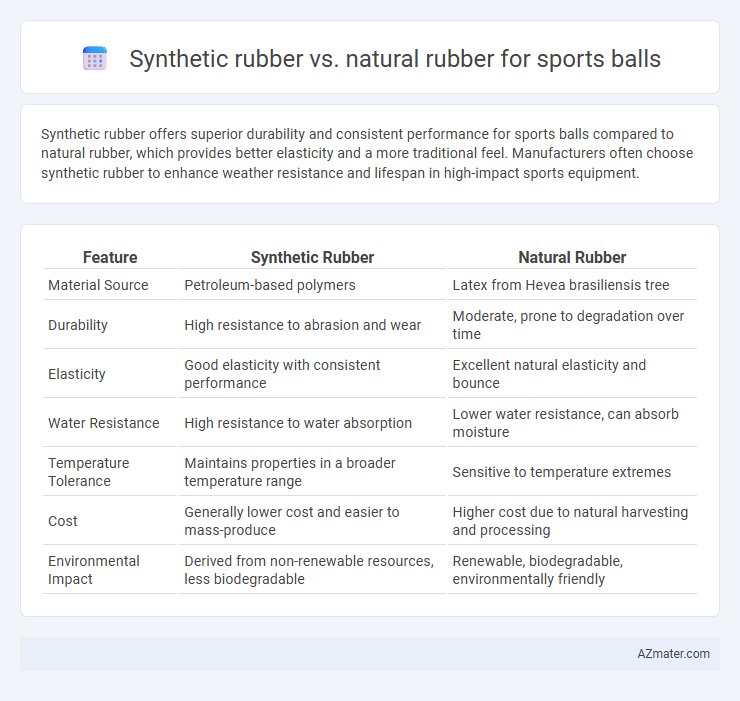Synthetic rubber offers superior durability and consistent performance for sports balls compared to natural rubber, which provides better elasticity and a more traditional feel. Manufacturers often choose synthetic rubber to enhance weather resistance and lifespan in high-impact sports equipment.
Table of Comparison
| Feature | Synthetic Rubber | Natural Rubber |
|---|---|---|
| Material Source | Petroleum-based polymers | Latex from Hevea brasiliensis tree |
| Durability | High resistance to abrasion and wear | Moderate, prone to degradation over time |
| Elasticity | Good elasticity with consistent performance | Excellent natural elasticity and bounce |
| Water Resistance | High resistance to water absorption | Lower water resistance, can absorb moisture |
| Temperature Tolerance | Maintains properties in a broader temperature range | Sensitive to temperature extremes |
| Cost | Generally lower cost and easier to mass-produce | Higher cost due to natural harvesting and processing |
| Environmental Impact | Derived from non-renewable resources, less biodegradable | Renewable, biodegradable, environmentally friendly |
Introduction to Rubber Types in Sports Balls
Synthetic rubber and natural rubber both play crucial roles in the manufacturing of sports balls, each offering distinct properties tailored to performance needs. Natural rubber, sourced from latex of rubber trees, is prized for its high elasticity, resilience, and excellent grip, making it ideal for balls that require superior bounce and control. Synthetic rubber, typically made from polymers like styrene-butadiene or neoprene, provides enhanced durability, weather resistance, and consistent performance in diverse playing conditions, which is essential for maintaining ball integrity during intense sports activities.
Overview of Natural Rubber Properties
Natural rubber, derived from the latex of Hevea brasiliensis trees, exhibits high tensile strength, excellent elasticity, and superior resilience, making it ideal for sports balls requiring durability and optimal bounce. Its natural polymer structure allows for excellent vibration dampening and a soft, tactile feel, enhancing player control and comfort. Compared to synthetic rubber, natural rubber offers better abrasion resistance and is more environmentally sustainable, though it may be more sensitive to temperature variations and aging.
Overview of Synthetic Rubber Properties
Synthetic rubber used in sports balls offers enhanced durability, consistent elasticity, and superior resistance to abrasion compared to natural rubber. Its chemical composition allows for better control over hardness and resilience, which improves ball performance in various weather conditions. Advanced synthetic polymers like styrene-butadiene rubber (SBR) are commonly utilized to achieve optimal bounce and longevity in sports equipment.
Performance Differences: Synthetic vs. Natural Rubber
Synthetic rubber offers superior abrasion resistance and consistent bounce characteristics compared to natural rubber, making it ideal for high-performance sports balls used in professional settings. Natural rubber provides better elasticity and a softer feel, enhancing grip and control for players in sports like basketball and volleyball. The choice between synthetic and natural rubber impacts durability, bounce uniformity, and overall ball responsiveness during gameplay.
Durability and Longevity in Sports Applications
Synthetic rubber offers superior durability and resistance to abrasion, making sports balls more resilient to harsh outdoor conditions and repeated impacts. Natural rubber provides excellent elasticity and grip but tends to degrade faster under UV exposure and extreme weather, reducing ball longevity. For sports applications demanding consistent performance and extended lifespan, synthetic rubber is often preferred due to its enhanced wear resistance and stability.
Environmental Impact: Sustainability and Sourcing
Synthetic rubber used in sports balls often relies on petrochemical sources, leading to higher carbon emissions and reliance on non-renewable resources, whereas natural rubber is harvested from rubber trees, promoting renewable sourcing and potentially lower environmental footprints when managed sustainably. Natural rubber plantations can support biodiversity and carbon sequestration but may cause deforestation and habitat loss if not responsibly cultivated. Sustainable sourcing certifications like FSC for natural rubber and innovations in bio-based synthetic rubbers aim to mitigate environmental impacts in sports ball manufacturing.
Cost Comparison: Production and Retail Pricing
Synthetic rubber generally offers lower production costs compared to natural rubber due to its consistent raw material supply and scalability in manufacturing, leading to more stable pricing in sports ball production. Natural rubber, derived from latex sap of rubber trees, experiences price volatility influenced by environmental factors and harvesting labor costs, often resulting in higher retail prices for sports balls made from this material. Retail pricing for synthetic rubber sports balls tends to be more competitive, making them a preferred choice for budget-conscious consumers without significantly compromising performance.
Player Experience: Feel and Playability
Synthetic rubber offers consistent bounce and durability, enhancing the feel and playability of sports balls in various weather conditions. Natural rubber provides superior grip and a softer touch, contributing to a more comfortable and responsive player experience. The choice between synthetic and natural rubber directly impacts ball control, impact absorption, and overall performance on the field or court.
Popular Sports Balls: Material Preferences
Synthetic rubber is commonly preferred in manufacturing popular sports balls such as basketballs, soccer balls, and volleyballs due to its superior durability, water resistance, and consistent performance under varying conditions. Natural rubber, valued for its elasticity and grip, is primarily used in baseballs and tennis balls where tactile response and softness are critical. The choice between synthetic and natural rubber in sports balls hinges on the specific performance characteristics required for each sport, balancing factors like resilience, texture, and environmental resistance.
Choosing the Right Rubber for Optimal Performance
Synthetic rubber offers superior durability, consistent bounce, and enhanced resistance to weather conditions, making it ideal for sports balls used in outdoor and high-impact games. Natural rubber provides excellent elasticity and a softer touch, preferred for sports balls requiring better grip and control in indoor settings. Selecting the right rubber depends on sport-specific needs, balancing performance factors like resilience, texture, and environmental adaptability.

Infographic: Synthetic rubber vs Natural rubber for Sports ball
 azmater.com
azmater.com